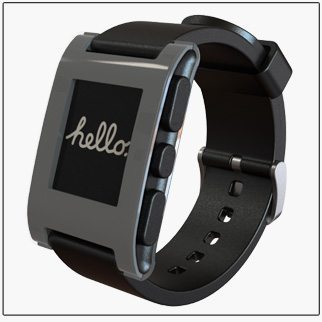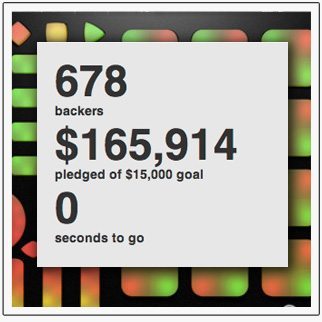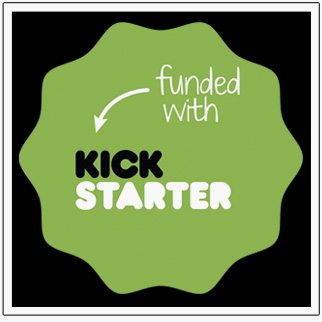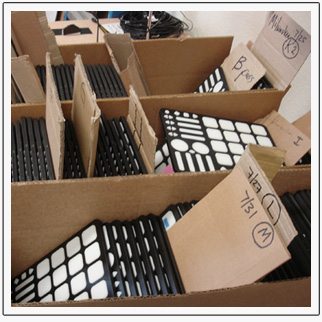In 2012, Kickstarter—the most popular crowd-funding site—turned a handful of little-known entrepreneurs into millionaires. These innovators, game designers and artists came up with ideas, set dollar goals for their campaigns, and watched as strangers scrambled to throw money at them. How well does Kickstarter really work in the context of bringing DJ controllers and other hardware to market? Today we take an in-depth look at the story of Keith McMillen’s QuNeo controller and the Kickstarter project that supported it.
 One of the most talked-about Kickstarter campaigns is Pebble Technology’s programmable wristwatch, which raked in an unprecedented $10.3 million dollars in funding (the goal was $100,000). But then came the hard part: manufacturing and shipping 85,000 watches. Like 75 percent of other technology- and design-related projects on Kickstarter (as reported by Bloomberg), Pebble Technology didn’t hit their target date and hasn’t yet delivered on their promises. As of September 5, the company hadn’t announced a ship date for the Pebble watch, although their regular progress reports (featuring videos, photos, and FAQs) are somewhat reassuring for backers.
One of the most talked-about Kickstarter campaigns is Pebble Technology’s programmable wristwatch, which raked in an unprecedented $10.3 million dollars in funding (the goal was $100,000). But then came the hard part: manufacturing and shipping 85,000 watches. Like 75 percent of other technology- and design-related projects on Kickstarter (as reported by Bloomberg), Pebble Technology didn’t hit their target date and hasn’t yet delivered on their promises. As of September 5, the company hadn’t announced a ship date for the Pebble watch, although their regular progress reports (featuring videos, photos, and FAQs) are somewhat reassuring for backers.

In January, another technology company successfully funded its Kickstarter campaign, but this one wasn’t a startup. Keith McMillen, the founder of Keith McMillen Instruments (KMI), has built and marketed music gear for 30 years. In 2012, he decided to launch KMI’s QuNeo 3D Multi-touch Pad Controller using crowd-funding.
“A lot times I’ll develop an instrument and wait until it’s finished to announce it, and that’s safer from a PR/timing perspective,” McMillen says. “But Kickstarter was fascinating, and it really did exemplify the viral capabilities of an Internet universe. A third of the supporters came in during the last 48 hours. John Paul Jones from Led Zeppelin came in, and Herbie Hancock came in with eight hours to go.” By the end date, the campaign brought in 678 backers and $165,914, blowing away KMI’s $15,000 goal.
 It helped that tech blogs such as Create Digital Music—as well as early praise from synth pioneer Tom Oberheim and musician Vernon Reid—ignited buzz about the QuNeo. The backers came running. “The potential to have a compact ‘touch sensitive’ controller was the last thing I felt I needed to control Ableton,” says supporter Chris Blarsky (aka deathstarchris) from Denver, Co.
It helped that tech blogs such as Create Digital Music—as well as early praise from synth pioneer Tom Oberheim and musician Vernon Reid—ignited buzz about the QuNeo. The backers came running. “The potential to have a compact ‘touch sensitive’ controller was the last thing I felt I needed to control Ableton,” says supporter Chris Blarsky (aka deathstarchris) from Denver, Co.
Based in Berkeley, Calif., KMI also attracted backers from as far as Istanbul, Turkey, including musician/sound designer Korhan Erel. “I prefer to be physically disconnected from the computer, especially the screen, which means controllers are essential for my playing,” he says. “The QuNeo is in some ways more advanced than the iPad, as it is more tactile and offers the pressure dimension.”
WRENCH IN THE MACHINE
After the QuNeo Kickstarter campaign closed, KMI hit the ground running to start production. The estimated ship date for the QuNeo was set for March, and a few lucky artist endorsees got their hands on the controller early, such as producer/rapper Thavius Beck.
Everything was going smoothly… at first. Then McMillen discovered that some of the “meatball, 4 cent components” were defective: “I called the manufacturer, and they go, ‘Well, it can’t be our components. We make 10 million of these every week.’ So I did like seven different prototype runs and kept sending them units, and they wouldn’t even look at them. Finally, at the end of March they said, ‘You’re right. The components are bad.’ That took four months.”

KMI’s team took on the arduous task of replacing 350,000 parts. A few weeks later, they discovered that the replacement components were also bad. “It was just horrible,” McMillen says. “My heart hit the ground, and they refused to even investigate.”
So McMillen bought sample components from 10 other manufacturers, did more testing and prototype runs, and when he received the third batch of components from a new manufacturer, production started moving. “I’ve been building stuff a long time but have never seen a company treat customers like this,” McMillen laments. “It was really frustrating because every experiment would take three to six weeks, and there was nothing to report.”
It brings into question the ethics of manufacturing in China. “It’s a land of great expansion,” McMillen says:
“It’s like the Wild West, and you’re gonna run into problems. Some of the stuff that goes into the QuNeo can only be built there because they have the most sophisticated machinery. If I tried to build this stuff in North America, it’s not even possible. So as a nation, we got ourselves into this, and there are pluses and minuses.”
CALL FOR COMMUNICATION
While McMillen did post updates on progress for the QuNeo, some backers and post-campaign buyers felt it wasn’t enough. One producer from Wisconsin, 1nvisibleMan, bought a QuNeo from KMI’s online store in February and wondered if the controller would ever arrive.“I received confirmation that my order had been processed and cashed but have yet to hear a word on its progress,” he says.
“The little I know I had to find searching the Kickstarter backers comments. Calling it a ‘debacle’ is too nice; it’s starting to feel more like theft. I sense the general feeling of backers has been that even simple status updates on delays and problems would alleviate unrest.”
But McMillen felt that communicating issues more might have confused matters. “I hate being a whiner and making excuses,” he says.
“I just know that people want results. One week everything would look fine, and the next week, all these horrors. If I had communicated some of the subtleties, which were not conclusive in tests, people would have probably thought I was psycho. So I put that energy into solving problems, and if there was something significant, I let them know.”
It didn’t help that artist endorsees could be seen performing with the controller well before backers got their hands on one. “When someone has invested in your product, they don’t really care about what caused the delay, they just want what they invested in,” Thavius Beck says. “The last thing you want is for eager investors to become disgruntled, especially when they see a guy like me who has a QuNeo all over the Internet months before anyone else.”
It’s particularly difficult for overseas backers. Erel’s unit was delivered at the end of August, but not to Istanbul. “If I had opted for international shipping, I would have had to pay a lot of tax, which would have driven the cost of the unit up to an unaffordable figure for me,” he says. “I was in New York from February to April, and was hoping to get my unit and bring it back home. Fortunately, I have several friends who go back and forth between Turkey and the U.S., and one of them will bring it to me.”
STRAIGHT SHOOTERS
 Despite production delays, McMillen is glad he launched the product through Kickstarter and appreciated the company’s no-nonsense style. “They say explicitly that you should make sure you’re ready to fulfill orders because it’s a lot harder than it looks,” McMillen says. “They’re very terse. They give you one report the day your campaign closes, and that’s it. They provide this platform, there are X tools, and they don’t promote you, but it works. They’re totally upfront. They tell you what they’re going to do, and they do it.”
Despite production delays, McMillen is glad he launched the product through Kickstarter and appreciated the company’s no-nonsense style. “They say explicitly that you should make sure you’re ready to fulfill orders because it’s a lot harder than it looks,” McMillen says. “They’re very terse. They give you one report the day your campaign closes, and that’s it. They provide this platform, there are X tools, and they don’t promote you, but it works. They’re totally upfront. They tell you what they’re going to do, and they do it.”
Although Kickstarter spokesperson Justin Kazmark declined to comment, he forwarded the company’s September 4 blog on “Accountability”, which addresses the risks of becoming a project backer and raises awareness about potential speed bumps that can occur with projects that are more difficult to pull off than anticipated.
Unfortunately, because Kickstarter is still a relatively new company (launched in 2009), there aren’t many protections in place should a project go completely off the rails. “If the problems are severe enough that the creator can’t fulfill their project, creators need to find a resolution,” the blog states. “Steps could include offering refunds, detailing exactly how funds were used, and other actions to satisfy backers.”

Technically, Kickstarter’s Terms of Use contract states that project creators are obligated to fulfill all rewards, but Kickstarter holds no responsibility for refunds—it’s buyer beware. The blog does reveal that in May, Kickstarter added guidelines for technology and design projects, requiring more information, planning, and a functional prototype. And the Kickstarter team allegedly patrols for projects suspicious of fraud.
Blarsky (deathstarchris), a KMI backer, successfully funded his own hardware project using Kickstarter: SYNTHBOY+. Over 30 percent of the funding came from Japan. “Kickstarter can expose your idea to a new group that might be half a world away,” he says. “Just because you think it will not take off locally, who knows what could be waiting on the other side of the world?”
But he’d like to see Kickstarter work harder to earn their 5 percent commission. “They need to talk with their applicants and see if these people have a grasp on logistics, manufacturing, and price points,” Blarsky says. “They are making money on people failing at starting their businesses, and that’s not right.”
A STARTUP PLAYGROUND
 But what about companies with proven track records? Should Kickstarter restrict hardware projects to startups, or does it make sense for established businesses—which are more likely to deliver on promises—to participate? Beck believes that if a manufacturer doesn’t need the money, they shouldn’t ask. “I think using Kickstarter solely as a marketing vehicle is dishonest,” he says.
But what about companies with proven track records? Should Kickstarter restrict hardware projects to startups, or does it make sense for established businesses—which are more likely to deliver on promises—to participate? Beck believes that if a manufacturer doesn’t need the money, they shouldn’t ask. “I think using Kickstarter solely as a marketing vehicle is dishonest,” he says.
But KMI doesn’t have the resources of, say, Apple. “We’re a small high-tech company in the music world,” McMillen says. “You always need money. Everything costs more than you think.”
Blarsky says more established companies should launch products via crowd-funding. “If there is little interest, then [the product] doesn’t get made and the company wastes no more effort in the design and development,” he says. “And a well-established company will deliver something.”
“With Kickstarter, most people feel they are pre-ordering a product, not investing in a company, and it has done a poor job delineating the difference. If more [established] companies tried this approach, the end customer would feel better knowing that the company will deliver because it could not afford the PR nightmare if it didn’t.”
On the flip side, while Beck loves the QuNeo and believes KMI did a good job using Kickstarter, he says crowd-funding may not be the right move for every manufacturer in need of investors. “There is a certain trust factor with your customers that can be easily tainted if you don’t get the roll out right,” Beck says. “I don’t know if that is worth the risk for a lot of companies.”
McMillen says the KMI team is discussing whether it will launch another product through Kickstarter. So far, it’s a possibility. As for Blarsky and Erel, they are a split decision in terms of whether they’d back another project from KMI. Blarsky is ready to go. Erel is hesitant, considering the hoops he has to jump through to get hardware to Istanbul.
Being on both sides of the fence (backer and project creator), Blarsky suggests that startups should be realistic. “Whether it be 10, 100, or 100,000 units, getting your supply chain figured out before you start could be the difference between success and accolades or failure and disgrace,” he says.
“Limit your rewards. If you sell out of your initial 200 pieces, sit down and figure out if you could release another 500 in an additional reward or whether that would put too much stress on your fledgling company.”
 While KMI’s estimated ship date for QuNeo was six months off the mark, the company did deliver. On August 30, KMI announced on its QuNeo Kickstarter blog that the last QuNeo was shipped, including units for non-backers such as 1nvisibleMan, who received his on September 5. “Once everything was perfect, we just hit the button, so now they’re flowing,” McMillen says.
While KMI’s estimated ship date for QuNeo was six months off the mark, the company did deliver. On August 30, KMI announced on its QuNeo Kickstarter blog that the last QuNeo was shipped, including units for non-backers such as 1nvisibleMan, who received his on September 5. “Once everything was perfect, we just hit the button, so now they’re flowing,” McMillen says.
He says distributors are reporting a high demand for the QuNeo. “We have set up production so that we can make 400 a day,” McMillen reveals. “Weeks from now, I think people will talk about all the cool things that they’re doing with it, and the delays will be forgotten.”
In the meantime, he appreciates that there’s an avenue for unknown inventors to get funding. “So many of the good ideas come from crazy people who have something that they’re passionate about,” McMillen says. “An ounce of passion is a valuable thing, and we do need ways to support those people.”
Thanks to Kylee for this great in-depth look at the story behind the QuNeo funding and production process. Stay tuned – next week we’ll be pushing a complete technical review of the QuNeo controller and how it works to control a variety of DJ and production software.











